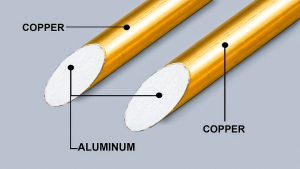Can I use #14 AWG Copper-Clad Aluminum conductors in my LED lighting circuits?
Overview
The ever-rising cost of conductors has dramatically increased the cost of electrical installations. At the same time, LED lighting has dramatically decreased the average energy consumption, and decreased the load on select bra nch circuits due to their low-energy nature. These two industry events paired together create an interesting opportunity. Why not permit smaller aluminum conductors for LED lighting loads? This would decrease the cost of the conductors, but not decrease the amount of available lighting, as LEDs pull so little current. In previous editions of the NEC this was not possible, as Section 240.4(D) only permitted #12 AWG copper-clad aluminum conductors. This has been expanded in the 2023 NEC to included #14 AWG copper-clad aluminum conductors specifically for the purpose of addressing higher conductor costs, paired with more efficient loads.
nch circuits due to their low-energy nature. These two industry events paired together create an interesting opportunity. Why not permit smaller aluminum conductors for LED lighting loads? This would decrease the cost of the conductors, but not decrease the amount of available lighting, as LEDs pull so little current. In previous editions of the NEC this was not possible, as Section 240.4(D) only permitted #12 AWG copper-clad aluminum conductors. This has been expanded in the 2023 NEC to included #14 AWG copper-clad aluminum conductors specifically for the purpose of addressing higher conductor costs, paired with more efficient loads.
Applying the 2023 Code
Section 240.4(D) lists the maximum permitted ampacities for small conductors (#18 AWG through #10 AWG). It is common knowledge that copper conductors are more expensive than their aluminum counterpart. Due to the rising cost of conductor material, the 2023 NEC now permits #14 copper-clad to be used on circuits rated 10 amperes or less (or 8 amperes continuous or less) per Section 240.4(D)(3). This helps set the stage for future 10 ampere LED lighting circuits. As lighting requires less current per lumen, it becomes wasteful to have only a few amps on a 20-ampere lighting circuit. This change will allow for conductors using less expensive, and smaller sized conductors to supply these smaller loads, and offer much greater flexibility when choosing conductor types for select circuits.
What’s New for the 2023 NEC?
2020 NEC
In the 2020 NEC Section 240.4(D) read as follows:
(D) Small Conductors.
Unless specifically permitted in 240.4(E) or (G), the overcurrent protection shall not exceed that required by (D)(1) through (D)(7) after any correction factors for ambient temperature and number of conductors have been applied.
(1) 18 AWG Copper. […]
(2) 16 AWG Copper. […]
(3) 14 AWG Copper. […]
(4) 12 AWG Aluminum and Copper-Clad Aluminum. […]
(5) 12 AWG Copper. […]
(6) 10 AWG Aluminum and Copper-Clad Aluminum. […]
(7) 10 AWG Copper. […]
2023 NEC
In the 2023 NEC Section 240.4(D) now reads as follows (subdivisions 1, 2, 4, 5, 6, 7, and 8 have been omitted):
(D) Small Conductors.
Unless specifically permitted in 240.4(E) or (G), the overcurrent protection shall not exceed that required by 240.4(D)(1) through (D)(8) after any correction factors for ambient temperature and number of conductors have been applied.
(1) 18 AWG Copper. […]
(2) 16 AWG Copper. […]
(3) 14 AWG Copper-Clad Aluminum.
10 amperes, provided all the following conditions are met:
(1) Continuous loads do not exceed 8 amperes
(2) Overcurrent protection is provided by one of the following:
a. Branch-circuit-rated circuit breakers are listed and marked for use with 14 AWG copper-clad aluminum conductor.
b. Branch-circuit-rated fuses are listed and marked for use with 14 AWG copper-clad aluminum conductor.
(4) 14 AWG Copper. […]
(5) 12 AWG Aluminum and Copper-Clad Aluminum. […]
(6) 12 AWG Copper. […]
(7) 10 AWG Aluminum and Copper-Clad Aluminum. […]
(8) 10 AWG Copper. […]
